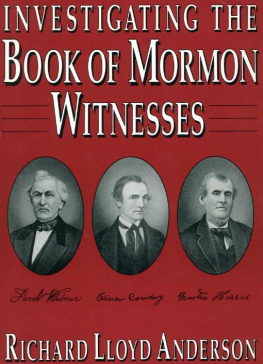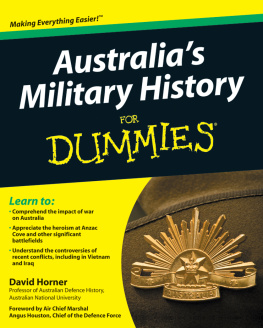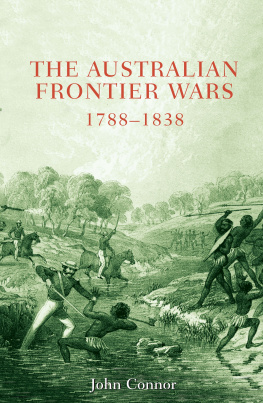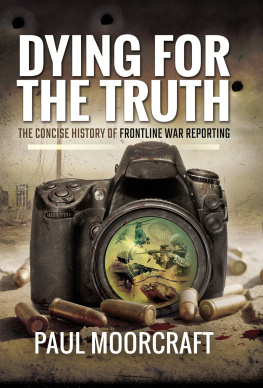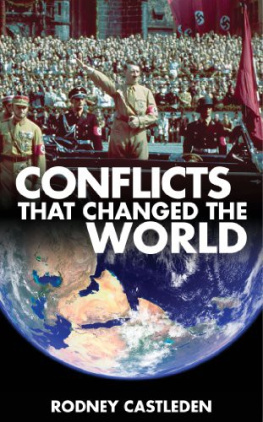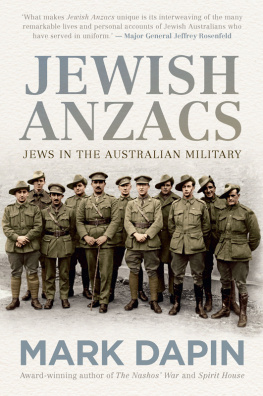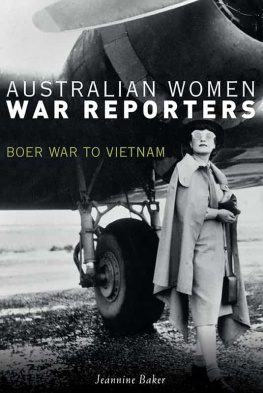Fay Ande rson is a lecturer at the Australian Centre in the School of Historical Studies at the University of Melbourne. She was educated at La Trobe University and the University of Melbourne . After graduating, Fay lived in Paris and Jerusalem for several years. Fays PhD thesis was published in 2005 by Melbourne University Publishing and entitled, An Historians Life: Max Crawford and the Politics of Academic Freedom .
Richard Trembath teaches history at the University of Melbourne. He has co-authored All Care and Responsibility , a history of the nursing profession in Victoria, and in 2005 published A Different Sort of War about the Australian experience of the Korean War. In 2008, Richard co-authored Divine Discontent , a new history of the Brotherhood of St Laurence. Much of Richards work has involved interviews and oral history. Currently he is researching the story of Australias indigenous soldiers.
CONTENTS
ACKNOWLEDGEMENTS
The research for this book was funded by a linkage grant from the Australian Research Council in partnership with the National Library of Australia, the CEW Bean Foundation and the Australian Centre at the University of Melbourne.
We would like to thank the National Library, in particular Margy Burns , Assistant Director-General , Australian Collections & Reader Services, the librarys Oral History staff who supplied the technical assistance for the recording and transcription of the many interviews we conducted and the staff in the Events and Education Section. Thank you also to Dame Elisabeth Murdoch who graciously provided additional funding to the project. The CEW Bean Foundation is dedicated to commemorating Australian war reporting and Jacqui Rees was our first invaluable contact. Jacqui introduced us to a major player in our researchSally White. Sally, who was also a member of the foundation, is a former journalist and academic. For the duration of the project she was a friend, counsellor and conduit to the wider world of journalism, in addition to reading and commenting on all our draft chapters. Without her this book would not have existed. Sally was also responsible for the questionnaires completed by current and former correspondents who provided us with crucial biographical data and many insights into the lives of our witnesses.
We owe a special debt of thanks to all the journalists who completed these questionnaires and to all those who agreed to be interviewed. The interviews were a vital part of our task of understanding how the Australian media reported on conflict. We cannot thank them enough for their time, generosity and willingness to answer our constant follow-up questions.
Staff at major archives assisted greatly in tracking down official files and personal papers. Within Australia these archives include the Australian War Memorial, the National Library of Australia, the National Archives of Australia, the Australian Broadcasting Corporation and the State Library o f V ictoria. In the United Kingdom we consulted papers at the National Archives and the Imperial War Museum and in the United States, the National Archives and Records Administration and the John F Kennedy Presidential Library. Many thanks also to Jane Wilson, Marketing & Communications Manager , ABC News, for assisting us in our search for photographs.
At MUP we thank Louise Adler, Elisa Berg and Lily Keil. Special thanks go to our tireless copy editor Penny Mansley who must have been horrified at the magnitude of the task before her. If so, she concealed her emotions and was assiduous in correcting grammatical and formatting horrors.
Thank you to all our wonderful colleagues at the Australian Centre. In particular, special mention goes to Jessica Carniel, Kiera Lindsay and James Waghorne.
Richard would like to acknowledge, as always, his friends, family and most importantly his wife , Anne Marie. Fay would like to thank her family and friends, and in particular Alex.
LIST OF ABBREVIATIONS
AAP Australian Associated Press
ABC Australian Broadcasting Commission/Corporation
ADF Australian Defence Force
AFP Agence France-Presse
AIF Australian Imperial Force
AJA Australian Journalists Association
ANL Associated Newspapers Limited
ANZAC Australian and New Zealand Army Corps
ANZUS Australia, New Zealand, United States Security Treaty
AP Associated Press
AWM Australian War Memorial
BBC British Broadcasting Corporation
Centcom United States Central Command
CIA Central Intelligence Agency
CNN Cable News Network
DOI Department of Information
DPR Directorate of Public Relations
DT Sydney Daily Telegraph
ITN Independent Television Network
MRT Media Reporting Teams
NAA National Archives of Australia
NARA National Archives and Records Administration (US)
NATO North Atlantic Treaty Organization
NBC National Broadcasting Company
NLA National Library of Australia
RAN Royal Australian Navy
RAR Royal Australian Regiment
SBS Special Broadcasting Service
SHAEF Supreme Headquarters Allied Expeditionary Force
SMH Sydney Morning Herald
SWPA South-West Pacific Area
TNA The National Archives (UK)
UN United Nations
UPI United Press International
INTRODUCTION
Getting the Story
During the battle of Passchendaele on the Western Front a year before the German surrender, the Australian war photographer Frank Hurley recorded in his diary: The battlefield was littered with bits of men, our own and Boche, and literally drenched with blood The sooner this hellish barbarism is ended God be praised, for few can see what real good can be gained. Known as the mad photographer for his propensity for getting close to the action, Hurleys candour was never given voice in the official reports during World War I. While Australian journalists on the frontline were given unprecedented access to the Australian troops, they were forbidden to report on military failure or the futility of war in either of the two world wars or in Vietnam, even though the latter is considered a watershed in conflict reporting. More contentious still, few journalists have been afforded unregulated access to report the Australian military experience since.
Last century was marked by war. Its first half was an age of destruction in which World War I left approximately ten million dead, and World War II had a death toll conservatively estimated at fifty-five million . As Susan Carruthers has observed, not only did more people die as a result of war in the twentieth century than in any previous century, but many experienced death as victims of mass extermination. Civilian collateral damage and the targeting of civilians became tragically commonplace. The two world wars shaped the twentieth century but by no means exhausted the toll inflicted during historys bloodiest hundred years. This present century had barely dawned when armies were marshalled in Afghanistan and Iraq, and the total number of casualties there is still unknown.
The issues of how foreign conflict has affected Australia and how it is reported to Australians are fundamental. It is often argued that war has defined Australia. World War I, as reported by the press, provided the template for one of Australias most enduring and potent narratives: the Anzac legend. Former prime minister John Howard once claimed that the first official war correspondent, CEW Bean (one of Frank Hurleys severest critics), was the most illustrious of all of Australias war correspondents, who shaped our understanding not only of the terrible cost of World War I but also of the Australian identity. Beans role is more contentious than Howard acknowledged. Bean did not develop the Anzac legend alone; nor was he even its original architect: that honour goes to a British correspondent, Ellis Ashmead-Bartlett. While journalists have continued to embrace the Anzac ideal, the military and the government have also appropriated it and have been its most protective guardians.


